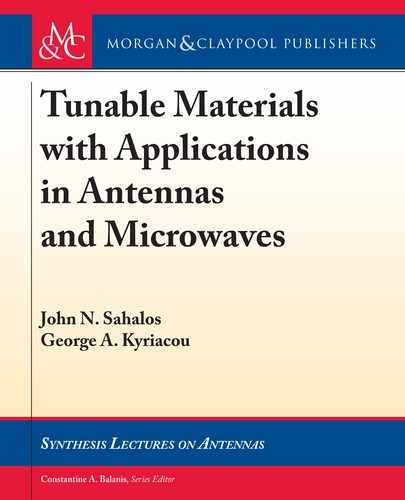
2.2. MICROWAVE FERRITES 19
2. Spin Magnetic Moments
Concerning the spin magnetic moments, in most solids, especially in compounds, electron spins
occur in pairs with opposite signs. is yields a negligible overall magnetic moment [13]. How-
ever, valence electrons and electrons in incompletely filled shells may have unpaired spins, which
result in a net magnetic moment. Materials of the transition series of the periodical table (Mg,
Mn, Co, Ni, Fe, Cr, Ti, etc.), in particular give rise to a strong overall magnetic moment due
to their unpaired electrons of the incomplete shells (especially the 3d sub-shell). More specifi-
cally, Hund’s rule [12] states that the electron of an incomplete shell will be so oriented that a
maximum number of unpaired spins is created. Even in these magnetic materials, electron spins
and, consequently, spin moments are randomly oriented so that their net magnetic moment is
still negligible. e most important feature that yields magnetic properties is that spin magnetic
dipole moments in each atom are free to align themselves along any applied external magnetic
field. After the removal of the external magnetic field, adjacent electron spin moments may
preserve their alignment due to the existence of exchange forces. e above gives rise to per-
manent magnetization phenomena, e.g., [12, 13]. e alignment tendency of these elementary
magnetic dipoles along the external magnetic field yields an increase in the total magnetic flux
density within the material.
2.2.5 ELECTRON MAGNETIC MOMENT—BOHR MAGNETON
e magnetic moment (m
0
) of an electron orbiting around the nucleus on a shell of radius r is
given in Figure 2.1 [12]. Herein, a normalized m
0
is considered, where free space permeability
0
is dropped. us, m
0
reads as follows:
m
0
D
1
2
e r
2
!; (2.1)
where e D 1:602 10
19
Cb is the electron charge and ! is the rotation circular frequency. e
above equation is derived by equating the electrostatic force of attraction, e
2
=.4"
0
r
2
/, between
the electron and the nucleus with the centripetal force m
e
r!
2
. "
0
is the free space permittivity
and m
e
D 9:107 10
31
Kg is the electron mass. In addition,
0
D 4 10
7
H/m and "
0
D
8:854 10
12
F/m.
e electron’s magnetic moment due to its spin can be expressed in terms of its angular
momentum. is is obtained from quantum mechanics as [12] j D „=2 D h=4, where „ D
h=2 and h D 6:547 10
34
J sec 4:1148 10
15
eV sec is Planck’s universal constant. In
fact, j D n „, where n is the quantum number. is number takes the values of n D ˙1=2 for
an electron spin. erefore, the magnetic moment of an electron due to its spin, also called “Bohr
magneton,” (
B
) is [12–14]:
m D
B
D
e
m
e
j D
e
m
e
h
4
D 9:274 10
24
Am
2
: (2.2)
..................Content has been hidden....................
You can't read the all page of ebook, please click here login for view all page.
